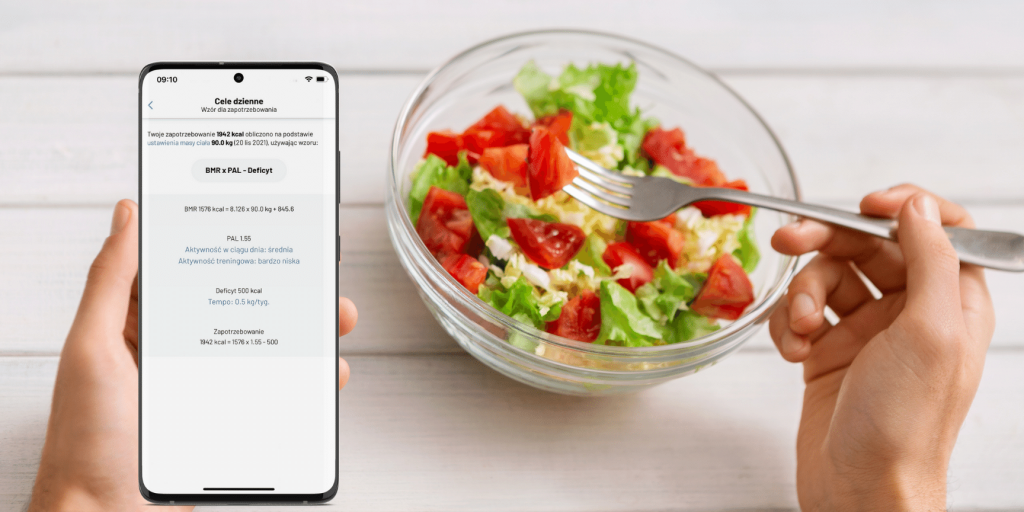What is a calorie deficit and how do you calculate it

A calorie deficit is something that anyone wishing to reduce their body weight should be familiar with. It is considered to be a safe method of shedding excess weight. However, in order for it to be effective, you need to know how to calculate a calorie deficit. Here are some tips!
What is a calorie deficit?
A caloric deficit, otherwise known as a negative energy balance, is a state in which the body burns more calories than it absorbs from food. Thus, it has to make use of other sources of energy, i.e. reserves stored in muscle and adipose tissue. The correct use of an energy deficit is perfectly safe. A well-balanced diet will allow you to see the first results after just one week of use.
How to calculate a calorie deficit?
To find out if you are on a calorie deficit, you need to calculate how many calories you burn per day or on average over the week. The easiest way to get this information is to buy a smart watch or bracelet. These devices monitor your health around the clock and are able to show you the number of calories burned around the clock and during specific activities. Keep in mind that the data the equipment shows you is not precise. They are only based on estimates. If you do not have such equipment, you can also try to estimate these values yourself.
Basal Metabolic Rate
In the first step, you need to calculate your Basal Metabolic Rate (BMR). This value shows how many calories your body needs to maintain vital functions (respiration, circulation and the work of other organs and systems). Readily available formulas such as Harris-Benedict, Mifflin or the FAO/WHO formula can be used to calculate BMR.
The Harris-Benedict formula is based on age, sex, weight and height.
| Male | Female |
| 66,47 + 13,7M + 5,0W – 6,76L | 655,1 + (9,567M) + (1,85W) – (4,68L) |
- M – body mass in kilograms
- W – height in centimetres
- L – age in years
The Mifflin formula is based on age, sex, weight and height.
| Male | Female |
| (10 x body weight in kg) + (6.25 x height in cm) – (5 x age in years) + 5 | (10 x body weight in kg) + (6.25 x height in cm) – (5 x age in years) – 161 |
The FAO/WHO formula is based on age, gender and body weight.
| Age | Male | Female |
| 11 – 18 years old | 17,686 * weight + 658,2 | 13,384 * weight + 692,6 |
| 19 – 30 years old | 15,057 * weight + 692,2 | 14,818 * weight + 486,6 |
| 31 – 60 years old | 11,472 * weight + 873,1 | 8,126 * weight + 845,6 |
| over 60 years old | 11,711 * weight + 587,7 | 9,082 * weight + 658,5 |
The FAO/WHO formula is widely recognised worldwide, which is why, among other things, we use it in the Fitatu calorie calculator.
Total metabolic rate
In the next step, you need to calculate your Total Metabolic Rate (TMR). This is a value that indicates how much energy your body needs for 24-hour activity.
To do this, BRM needs to be multiplied by the corresponding Physical Activity Level (PAL). It is worth knowing that the ratio depends not only on workout activity, but also on non-workout activity. To estimate this value, the following ratios are taken:
- 1.2 -1.3 – for a patient lying in bed;
- 1.4 – for low physical activity
- 1.6 – for moderate physical activity;
- 1.75 – for an active lifestyle;
- 2 – for very active lifestyle;
- 2.2-2.4 – for high-performance sport.
In a similar way, TMR can be calculated using an online calculator. As with BMR calculators, you need to enter your gender, height, age, body weight and, in addition, select the type of activity. Once you have filled in the data, the algorithm will give you the TMR value in calories.
Caloric deficit – meal calorie calculator
Once you have made the above calculations, you have been given information on how much energy you burn on average per day. Now, all you need to do is count how many calories you have consumed and subtract the resulting value from your TMR. This will tell you whether you have reached a calorie deficit. How do you calculate the calorie content of your meals? This is often the most difficult because you need to remember what you have eaten so that you can count everything accurately afterwards. It is therefore worth using the calorie calculators available – the Fitatu app has such a function. In the programme, you add the dishes you have eaten and are immediately informed of their calorie content and their protein, fat and carbohydrate content. You don’t have to calculate everything yourself on spreadsheets or on a piece of paper – the app will do it for you. Once you have logged in and filled in your details, the system will calculate the TMR.
Calorie deficit – what to eat?
First and foremost, you must remember that the daily calorie content of your meals must not be lower than your BMR. Consuming fewer calories will contribute to weakness and ultimately lead to cachexia. The deficit is related to the number of kilos you will lose each week. For example, 500 kcal corresponds to 0.5 kg per week and 1000 kcal corresponds to 1 kg per week. The deficit can be at 100-1000 kcal, but the safest values are between 200-500 kcal.
Foods that are easily digestible and rich in fibre should be the basis of the diet. Calories should be reduced by limiting carbohydrates and fats. Reducing the amount of protein in the diet risks a decrease in muscle mass. So whole grain products, vegetables in all forms, lean poultry meat and lean fish and fruit are recommended. To maintain a calorie deficit, you must give up baked goods made from white flour, all sweets and fast food. Nutritionists also recommend limiting the consumption of red meat and animal fat.
It is also a good idea to give up alcohol, as it has a lot of empty calories, i.e. calories that do not contribute any nutrients. In addition, one drink or pint of beer is usually not enough. On top of this, alcohol increases the appetite and this is an easy way to indulge in salty and sweet snacks, which are generally not healthy. This makes it easy to gain excess calories.
It is also a good idea to divide your daily food intake into 4-6 meals every 3-4 hours. Regularity of eating these meals is also conducive to proper weight loss. And don’t forget to hydrate. The best drinks are still mineral water and herbal teas. Freshly squeezed fruit and vegetable juices are also good from time to time.
What is the danger of a too high calorie deficit?
If you eat too few calories, you will not only increase the risk of the yo-yo effect, but also worsen your health. You will lose weight quickly at first, but this will be due to loss of water and muscle, which are broken down due to a state of starvation, rather than fat reduction. The body will not be able to withstand this state for long and will start to give signs of exhaustion. The most common signals are:
- excessive weakness;
- problems with concentration;
- memory disorders;
- rapid fatigue;
- deterioration of skin, hair and nails;
- hormonal disorders;
- decreased libido.
If you do not increase your calories, your metabolism is likely to slow down, your fitness will also decrease and fertility problems may occur.
What is the danger of an energy deficit that is too low?
A small difference between what your body needs and what you provide it with is not actually harmful. It simply won’t use its reserves, but the number of calories supplied will suffice. As a result, you will either not lose weight or the weight loss will be very slow. In such a situation, recalculate your energy requirements and try to count the calorie content of your meals accurately.
How do you introduce a calorie deficit? Do it with Fitatu!
Now that you know what a calorie deficit is and how to calculate it, there is nothing stopping you from starting your diet. The best way to do this is to start by drawing up a menu for the week and shopping based on it. Then you will avoid the temptation to put salty sticks or biscuits in your basket. If you are eating healthily, you may just need to increase the intensity of your exercise. Remember that movement contributes to a greater need for energy.
Don’t have time to count calories or write a menu? Download the Fitatu app from the Play Store or App Store and combine physical activity with a diet! What do you get after downloading the app? Access to: the largest product database in Poland, dishes with step-by-step recipes and how to prepare them, a barcode scanner and a calorie calculator. You can also upgrade to the premium version, in which you will receive, among other things, the possibility to create shopping lists, access to the web version of the application and more than 1,000 recipes, the database of which is extended every month. Check out the Fitatu app now!








